How to Restore and Season a Cast Iron Pan
Learn how to restore and season a cast iron pan. In this tutorial, I’ll show you how to easily remove rust and get that old pan back on the stove!
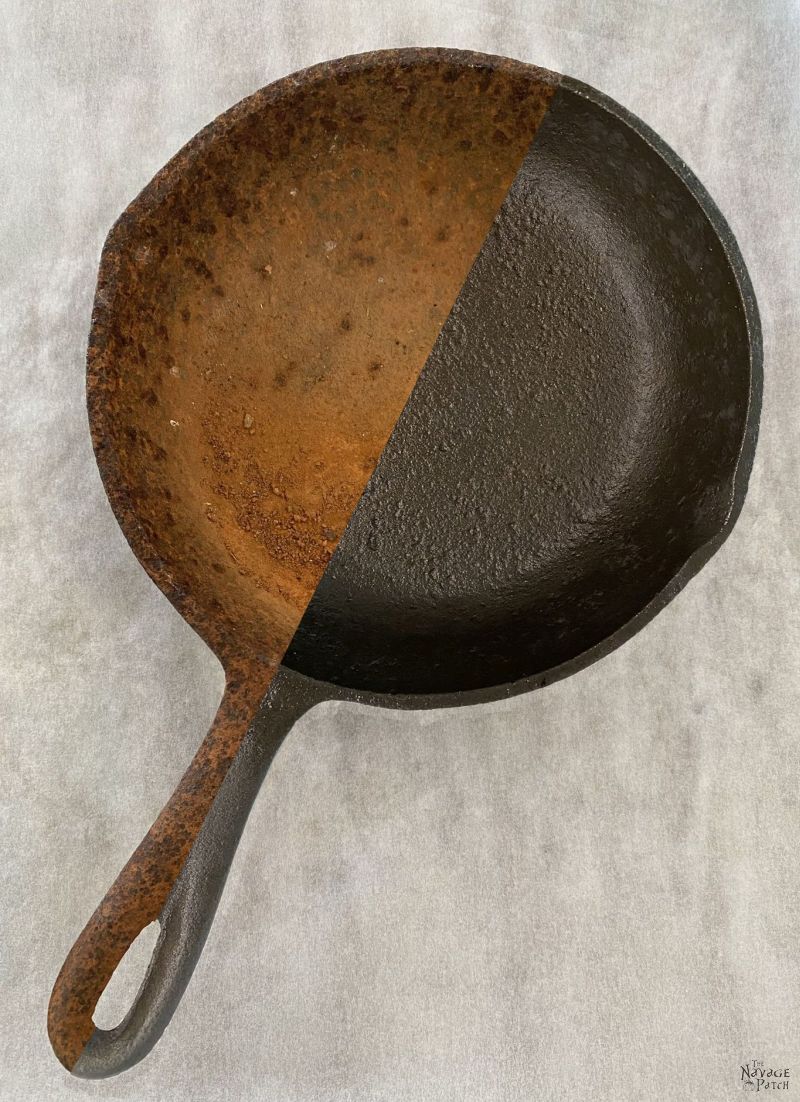
I love a good challenge.
Especially in the kitchen!
So Handan and I were out at our favorite antique shop the other day looking for props for my food posts. As we prepare to launch a dedicated food blog, I’m starting to up my food photography game. It’s an ultra-competitive field, and great photos are a must to succeed.
You’ve already seen some of the new-style photos. The first picture I took with my new props was to update my blue cheese dressing recipe.
I had to update that post first, because my recent buffalo chicken salad recipe calls for my blue cheese dressing. Couldn’t have such stylistic discord by keeping my crappy old blue cheese dressing photos!

And now, before I get to the cast iron pan restoration, I will leave you with the latest food photo I took with my new props. These are the brownies I made in The Giving Dish. This photo is nothing more than a teaser to whet your appetite for the recipe. 🙂
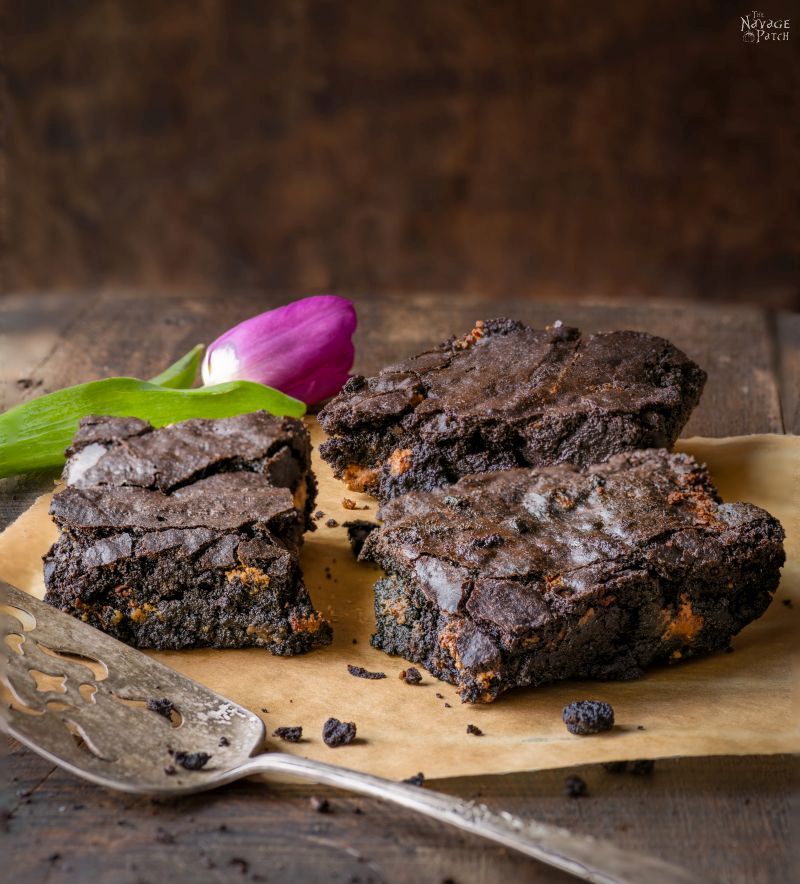
Okay, back to the cast iron pan…
As I said, my babes and I were out antiquing (anyone else not like that term?), and I spied this forlorn and forgotten cast iron pan in the corner of one of the consignment booths.
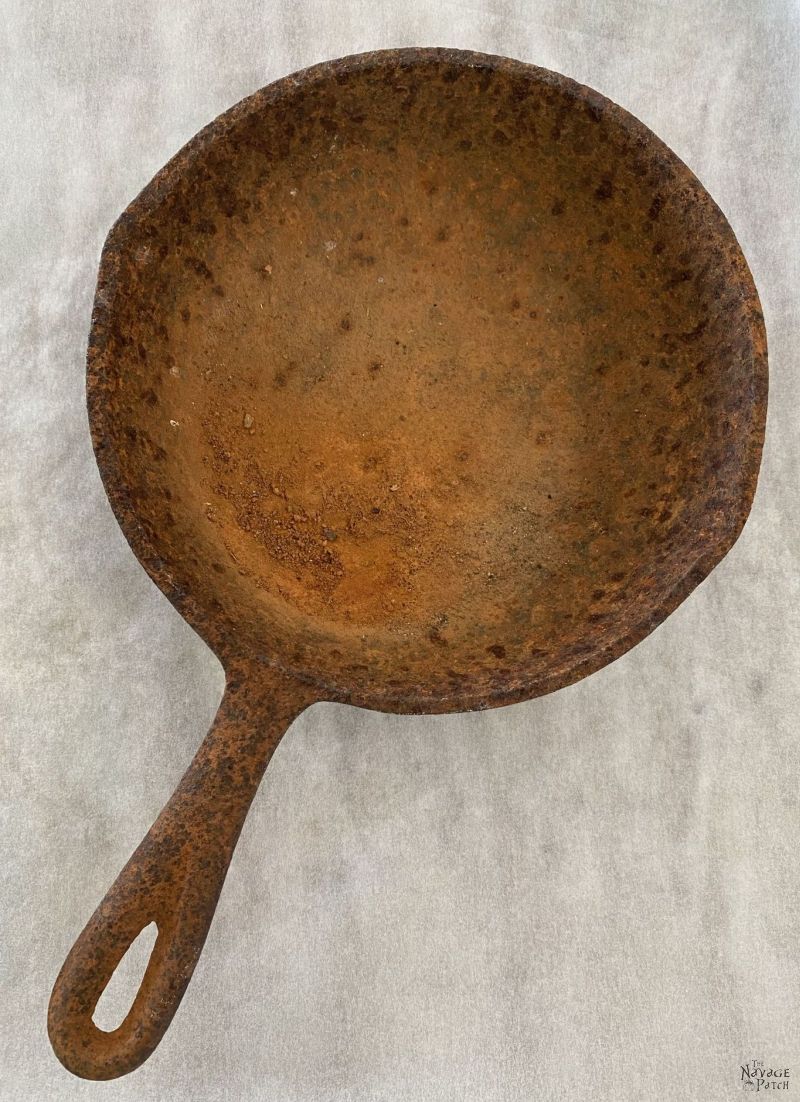
I’m no historian, but I’m pretty sure the last time this pan saw action, the Mid-Atlantic accent was still in fashion, and The National Horse Shoe Company was the darling stock of cigar-chomping Wall Street Banksters.
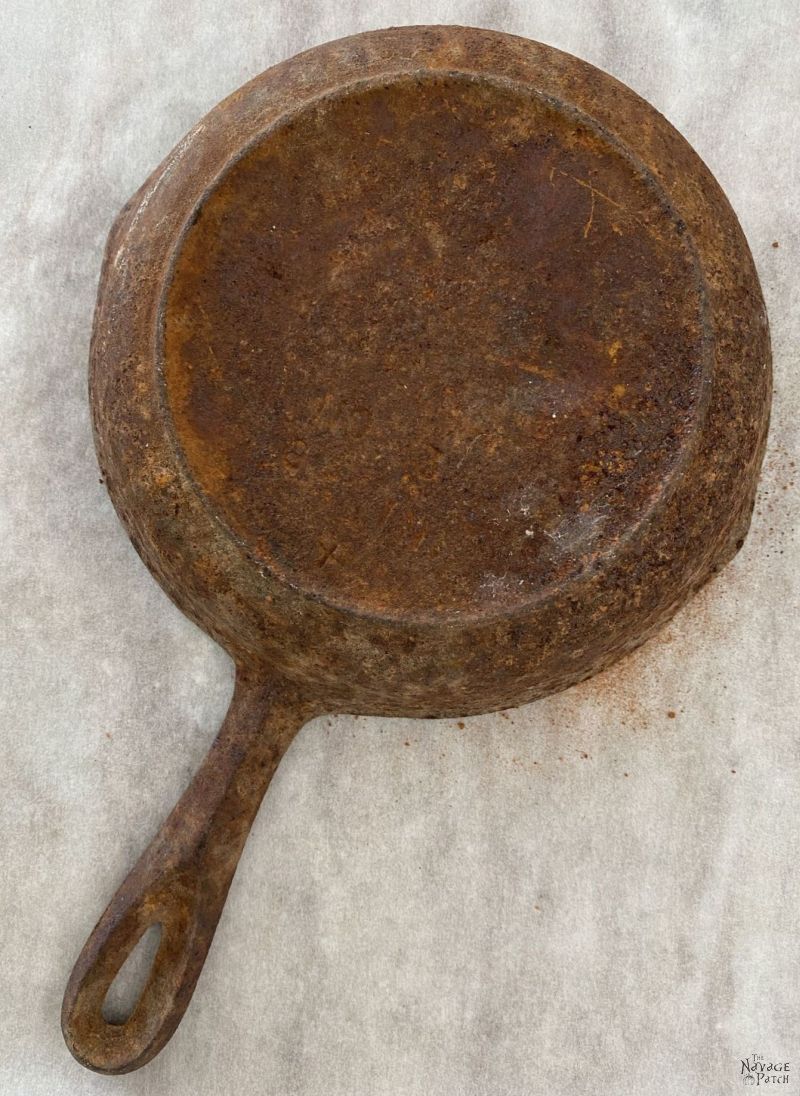
Of course, I knew immediately that I had to own such a useless artifact, rust, dust and all! I snatched my prize from its table and placed it atop the teetering prop-heap in our shopping cart.
My babes cast an eyeball in my direction.
“What?” I said. “I’m gonna restore it!”
Her eyeball slid down to my rusty treasure, then back up to me.
“Okay, my babes,” she said, and left it at that.
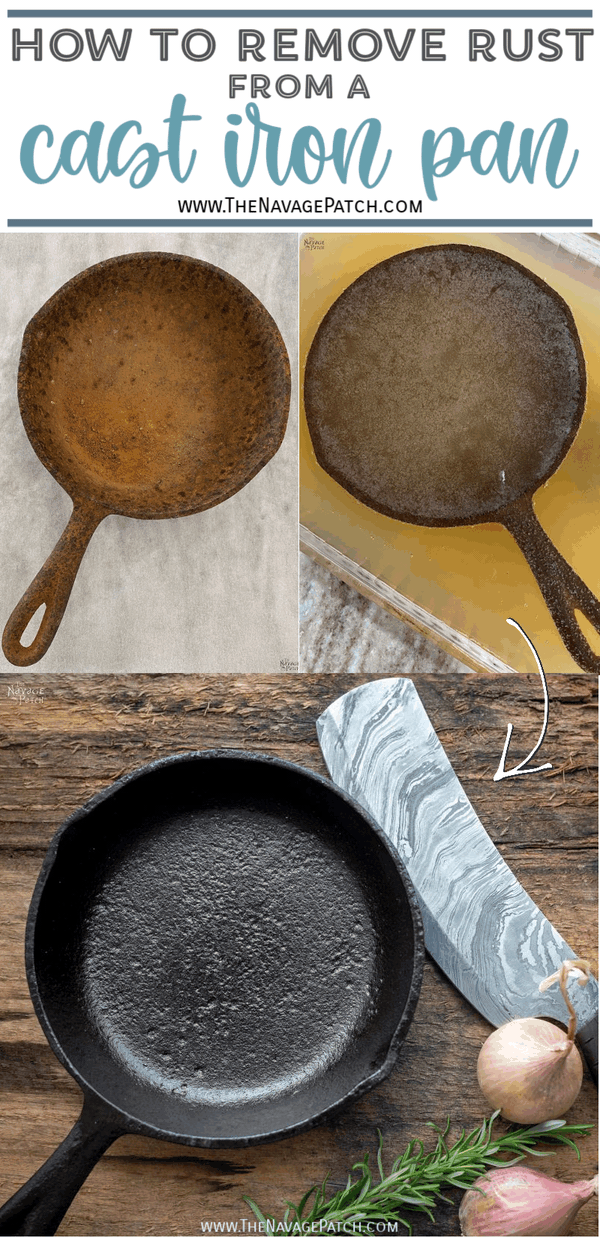
How to Restore a Cast Iron Pan
Once home, I set to work. For most rusty cast iron pans, a simple scrubbing with salt and an abrasive sponge will do the trick. But this wasn’t “most rusty pans.” This particular pan looked to have been corroding since the Coolidge administration.
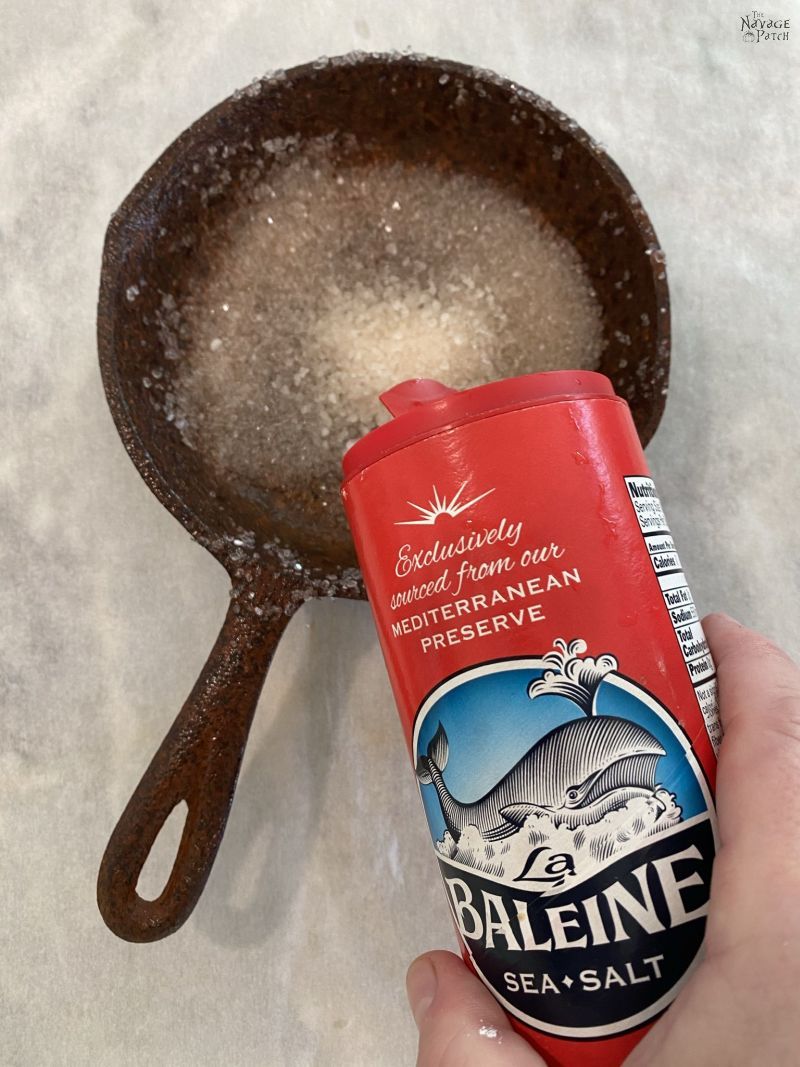
Still, I gave it a go with some coarse sea salt and a regular-duty green scrubby.
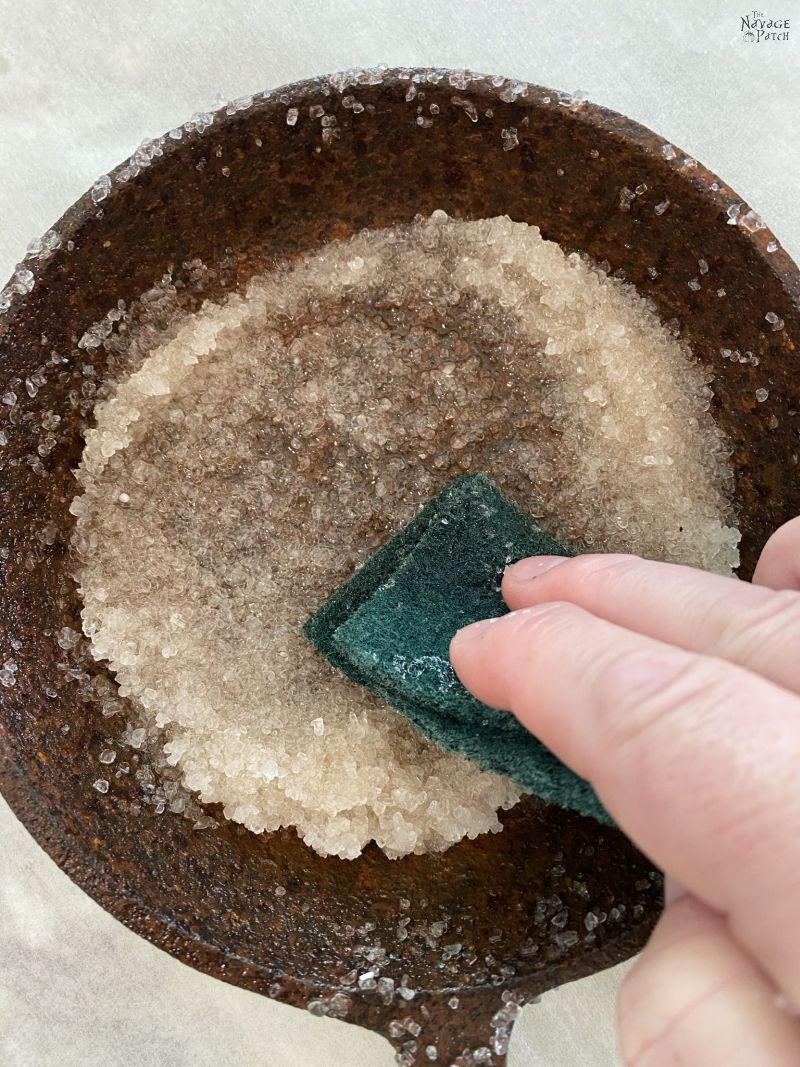
After 5 minutes, I knew I was on the wrong track, so I upgraded my weaponry. This copper scrubby should have the power I required.
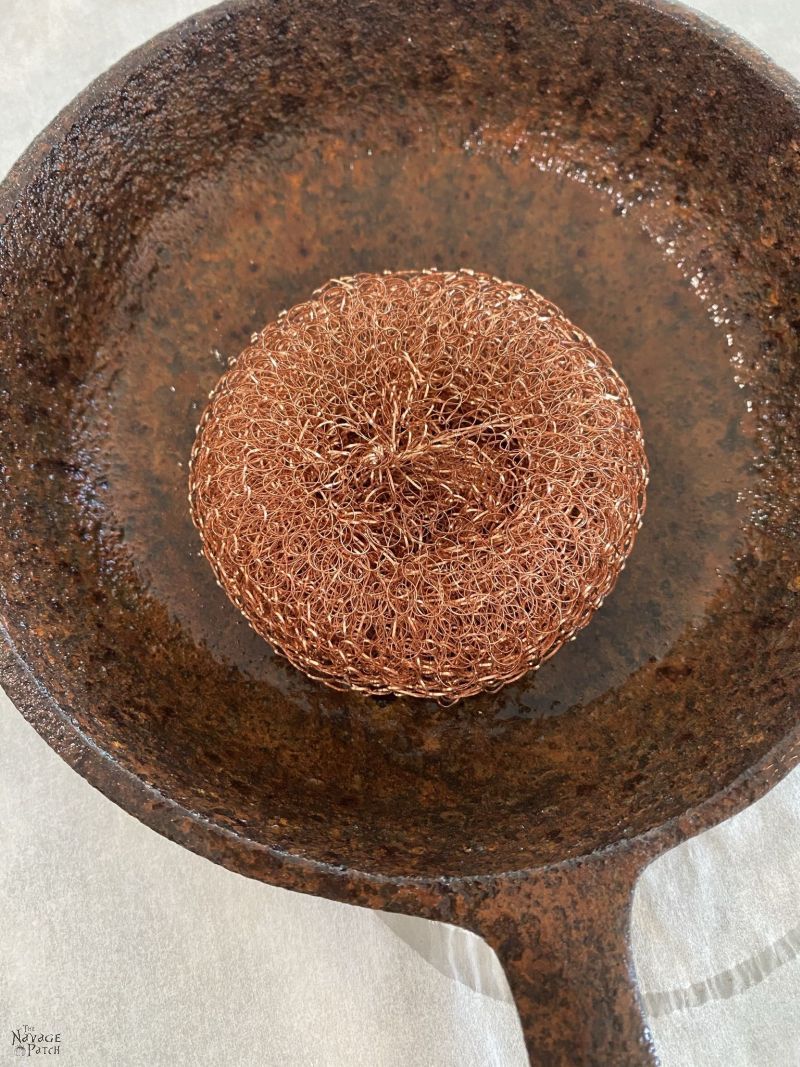
A little more salt to help my endeavor.
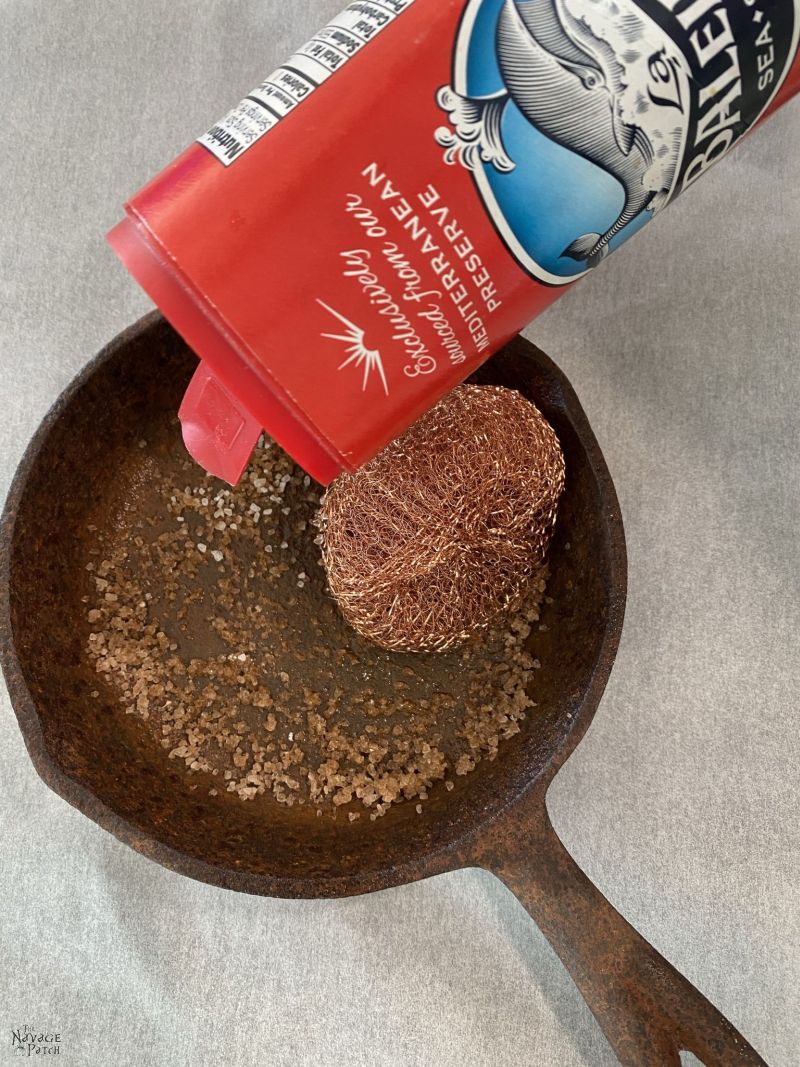
And after 10 minutes of grueling arm-work that would have made Popeye proud, I was still faced with this.
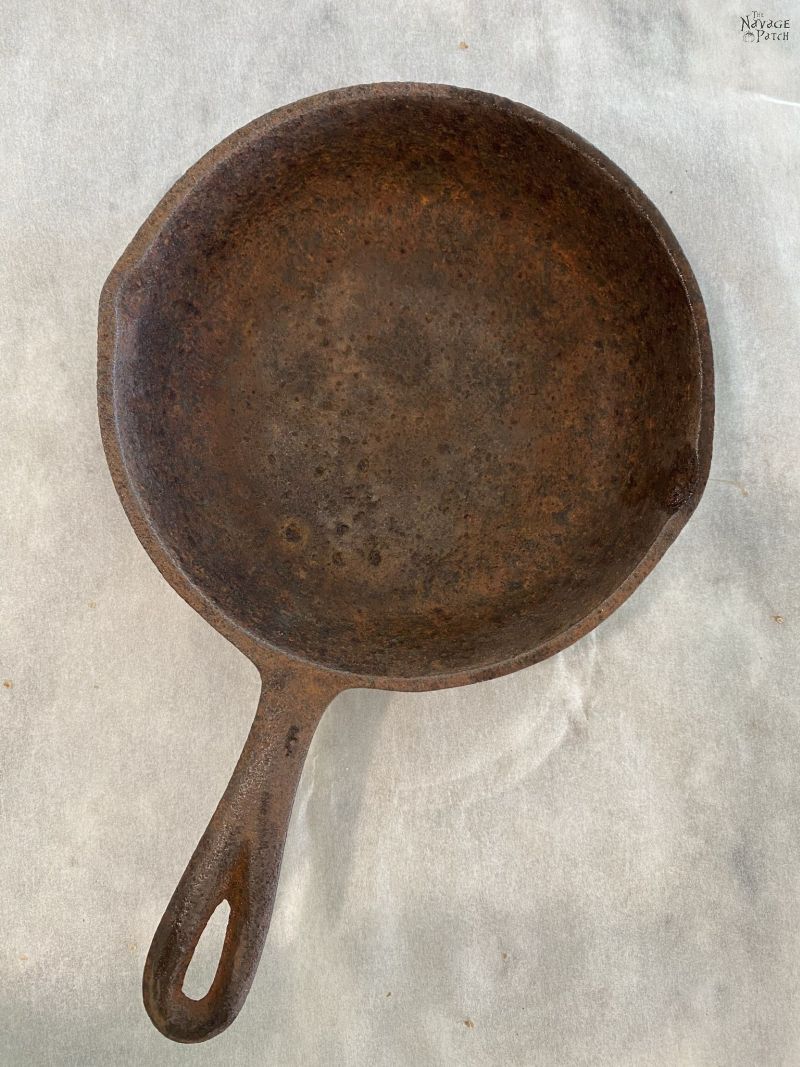
Worlds better, but still worlds away from being useful for anything other than a photo prop. And really, as a photo prop for a food blog, I don’t think it would work. Who wants to see food perched on or next to a rusty pan?
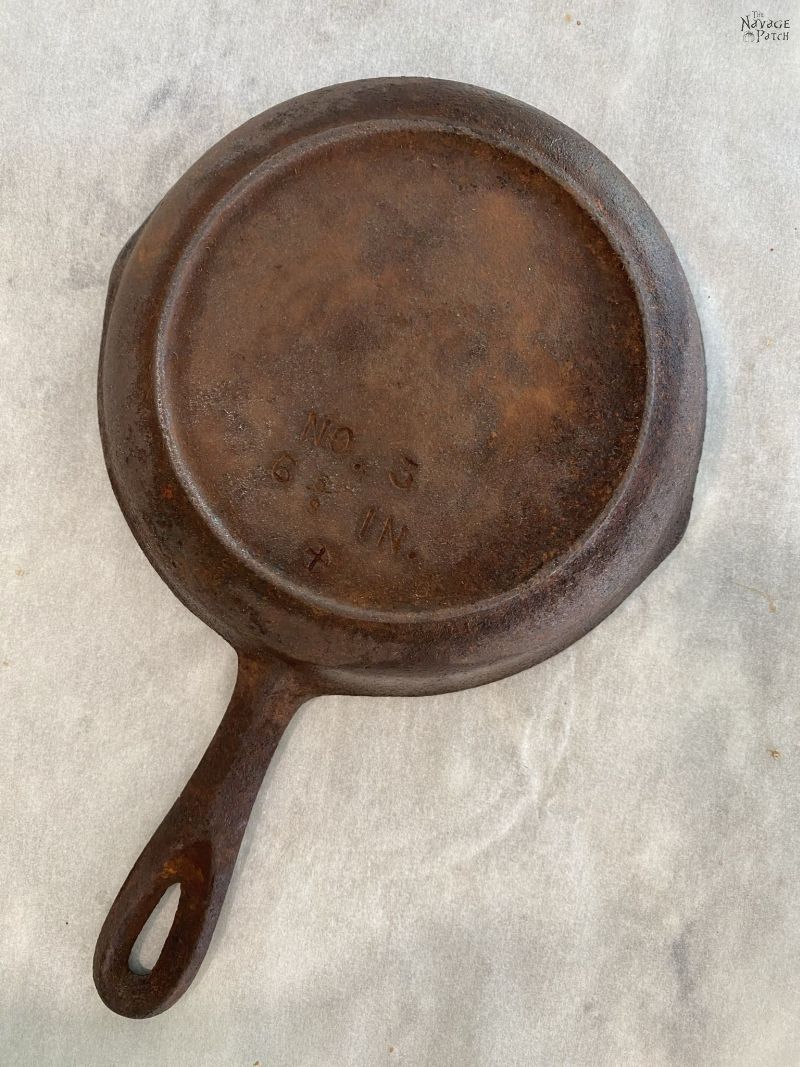
Whenever I’m stumped with a problem, I usually find the answer in a jug of distilled vinegar. This stuff is pure magic. As a dilute acid, it can work miracles on rust and other nasty buildups around the house.
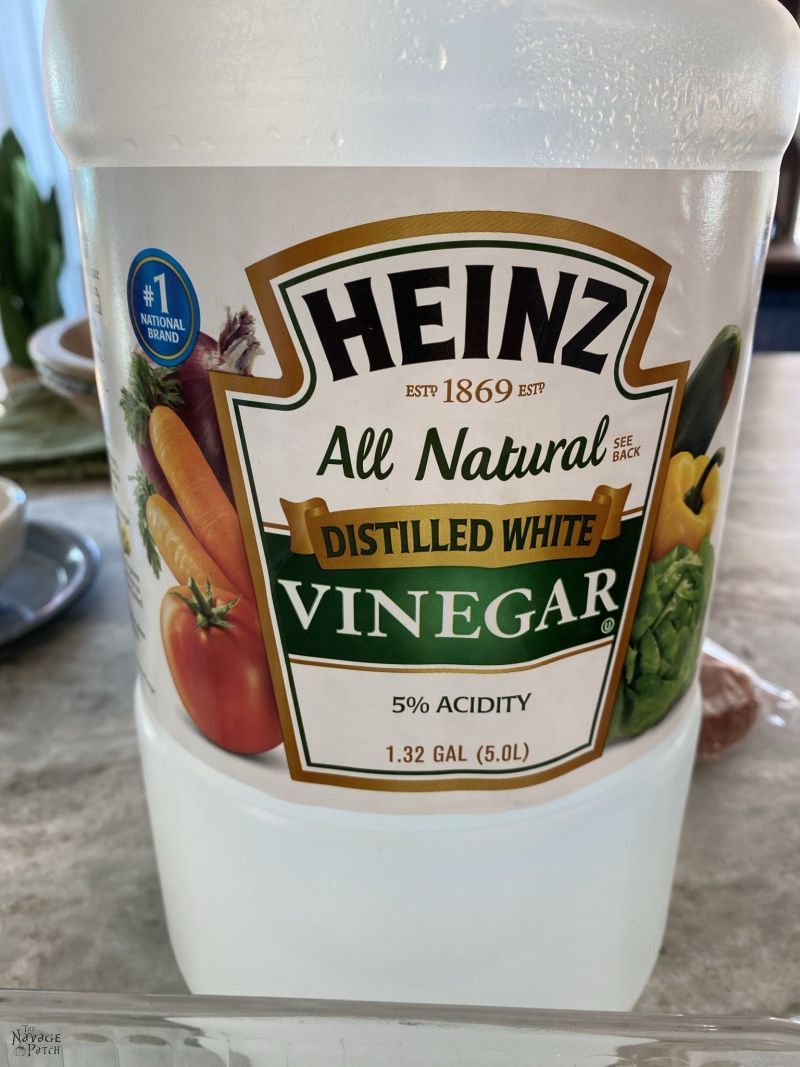
I set my pan in a baking dish large enough to hold it.
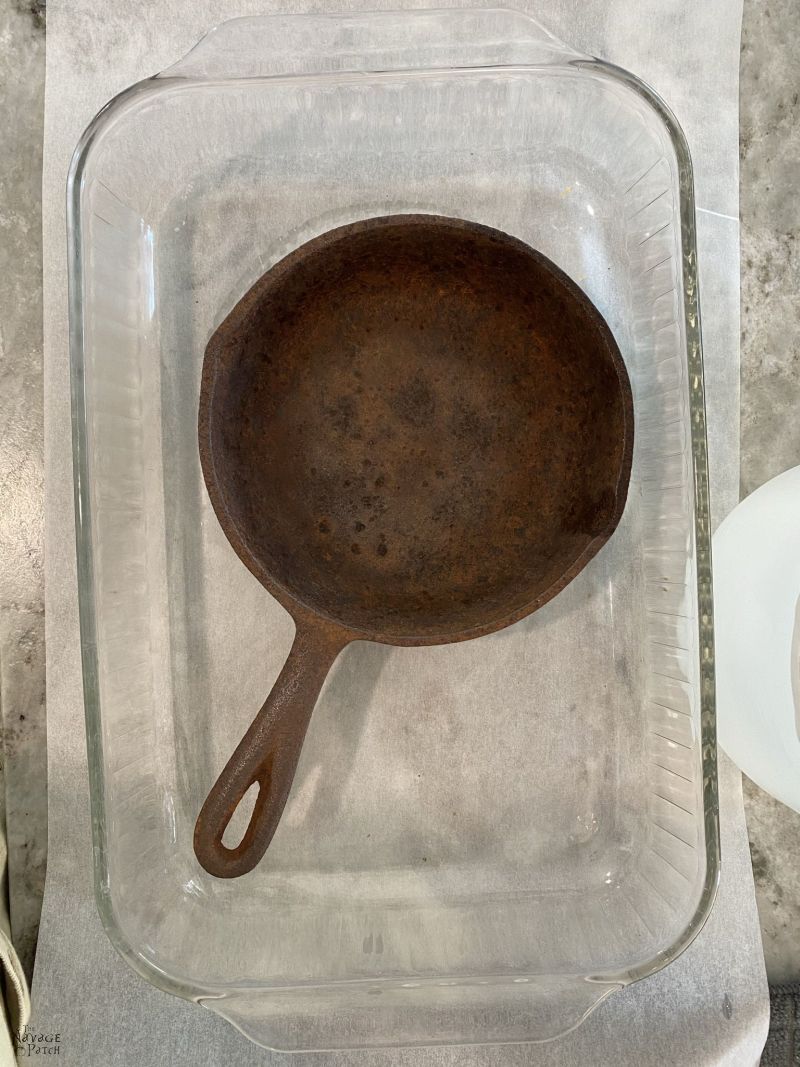
Then I filled the pan and baking dish with vinegar until the pan was completely submerged.
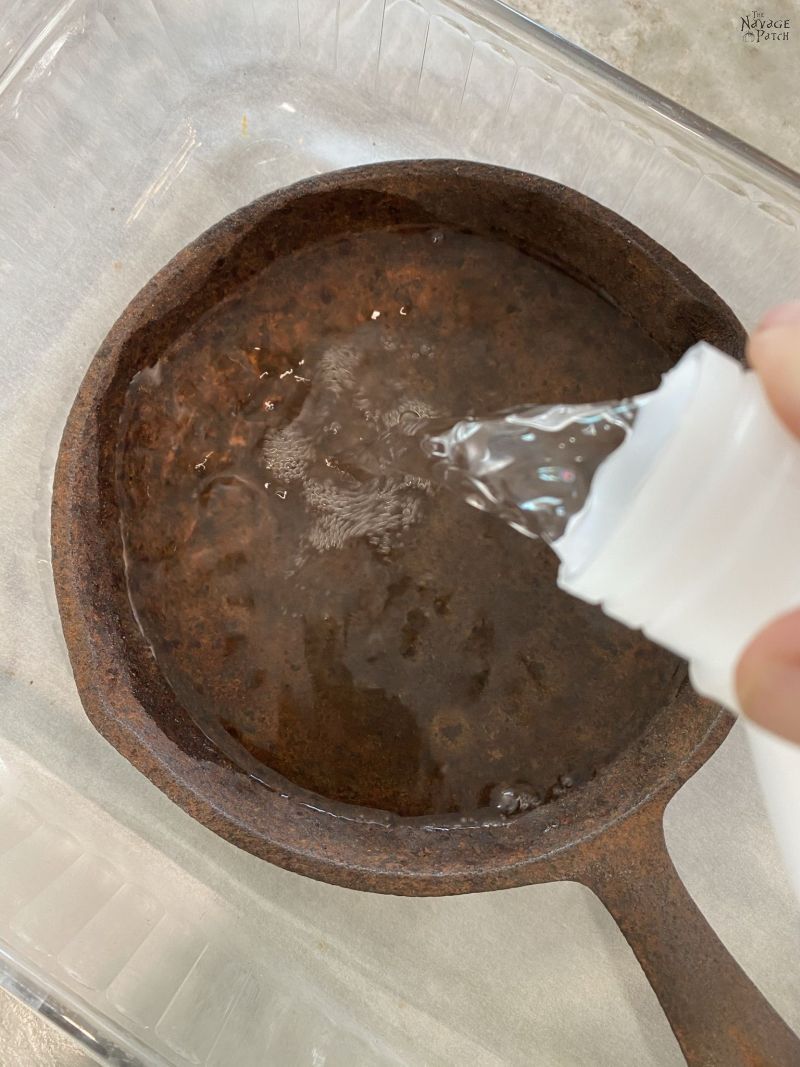
I’ve heard some say to leave a pan for 1 to 2 hours. This pan wasn’t a normal case. I left it all afternoon and overnight.
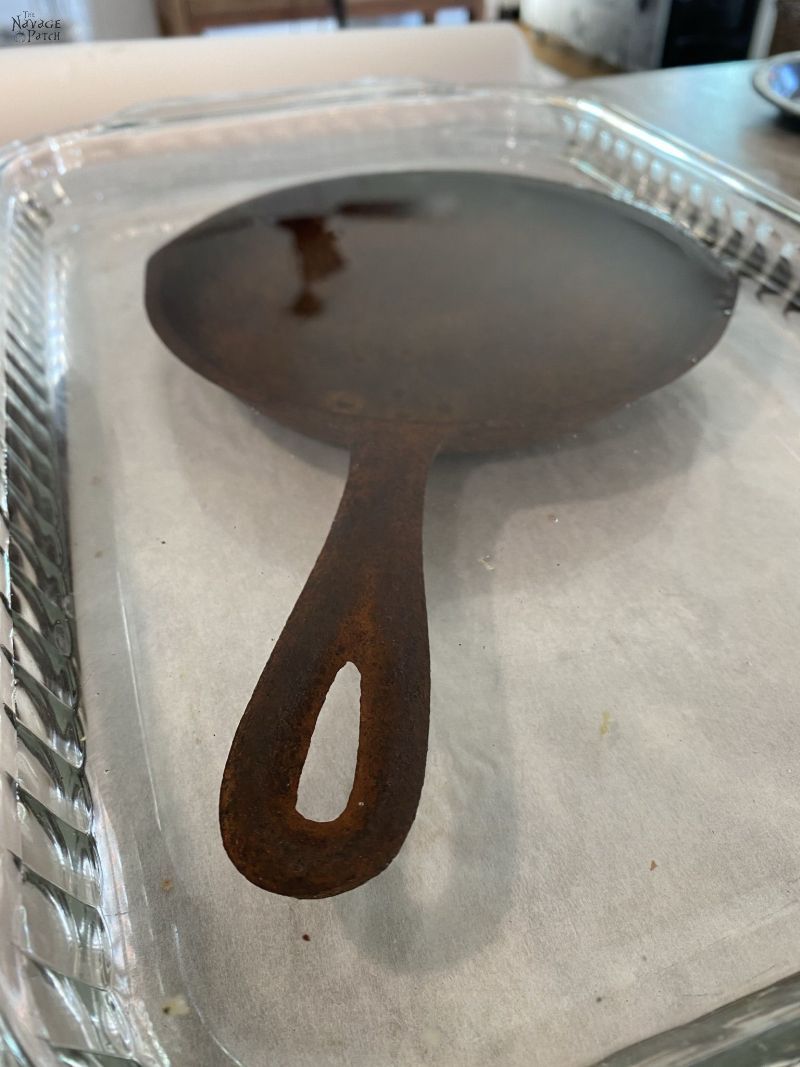
The next morning, it looked like this.
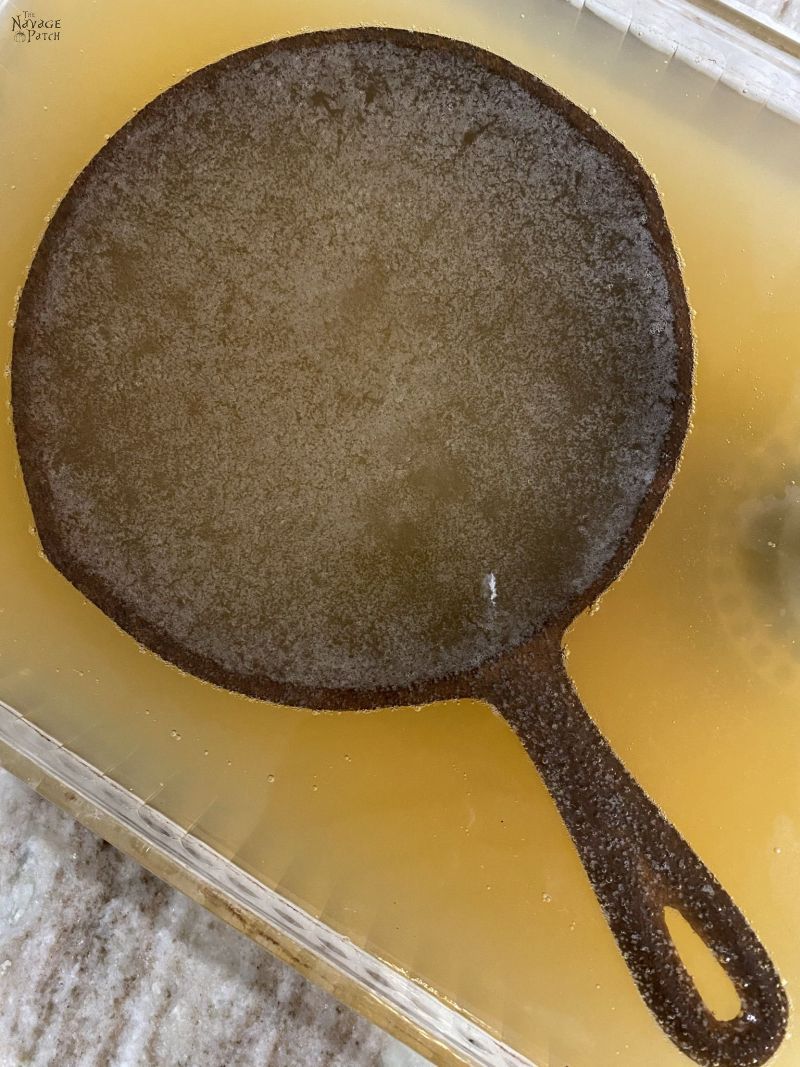
I pulled it out of its acidic bath, and to my dismay…it looked the same!
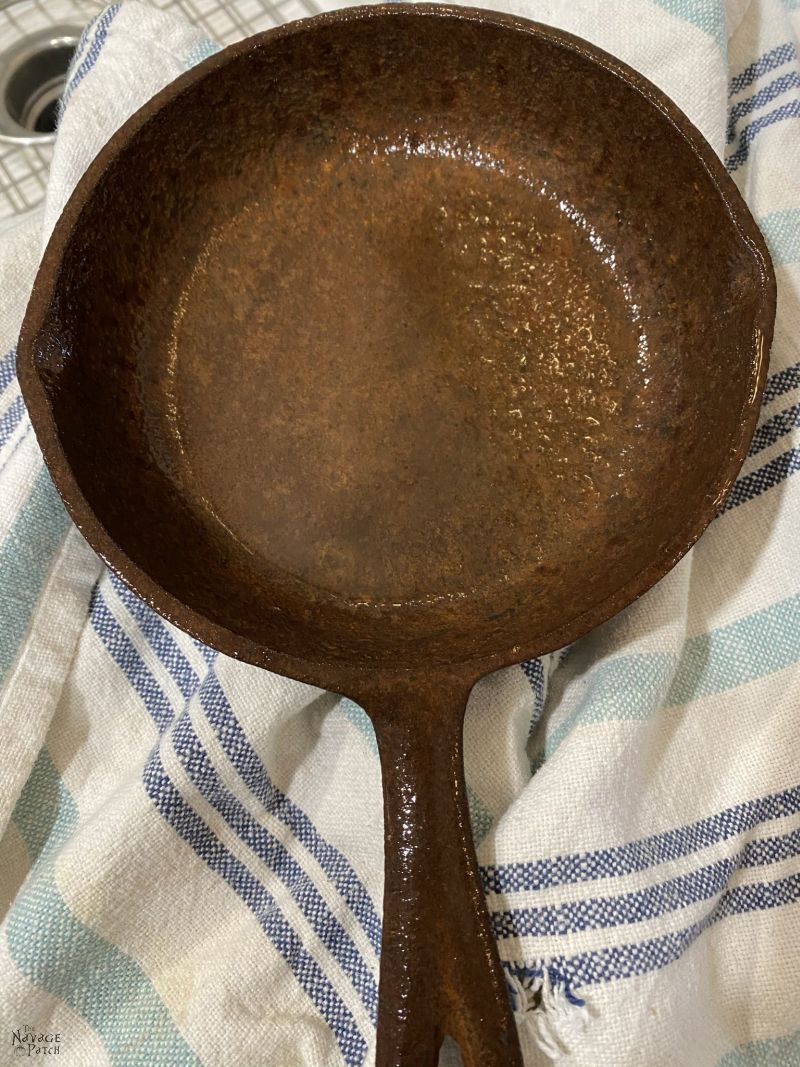
I figured I’d just rinse off the vinegar and give up, but then I decided to try scrubbing one more time.
Holy cow! The rust fell off with each scrub!
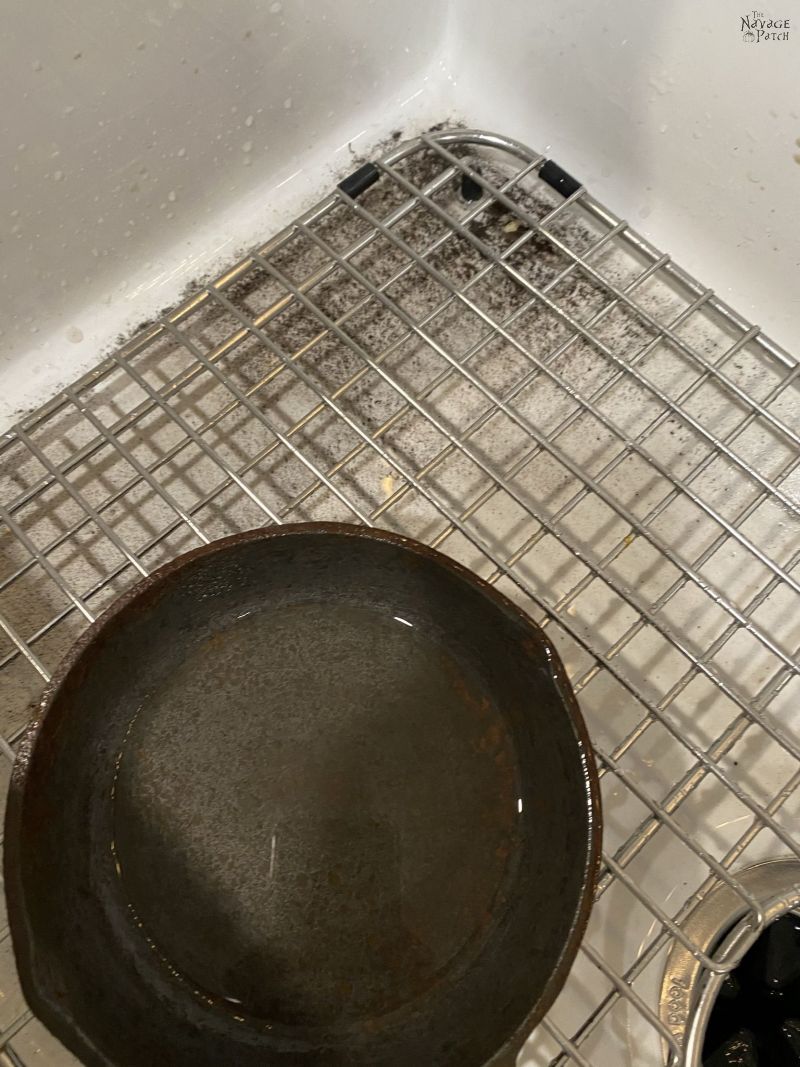
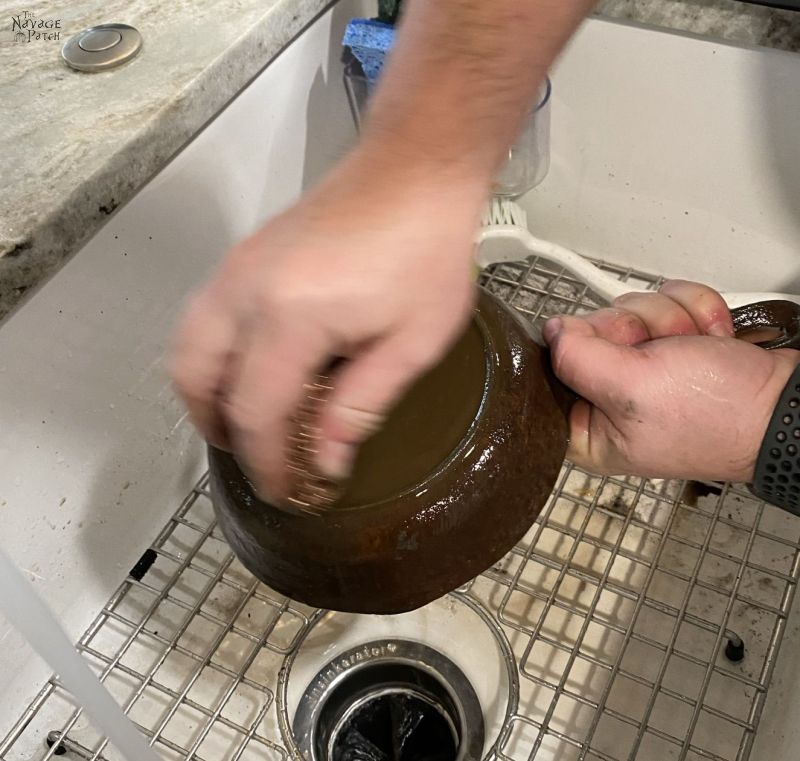
Chalk up another win for vinegar!
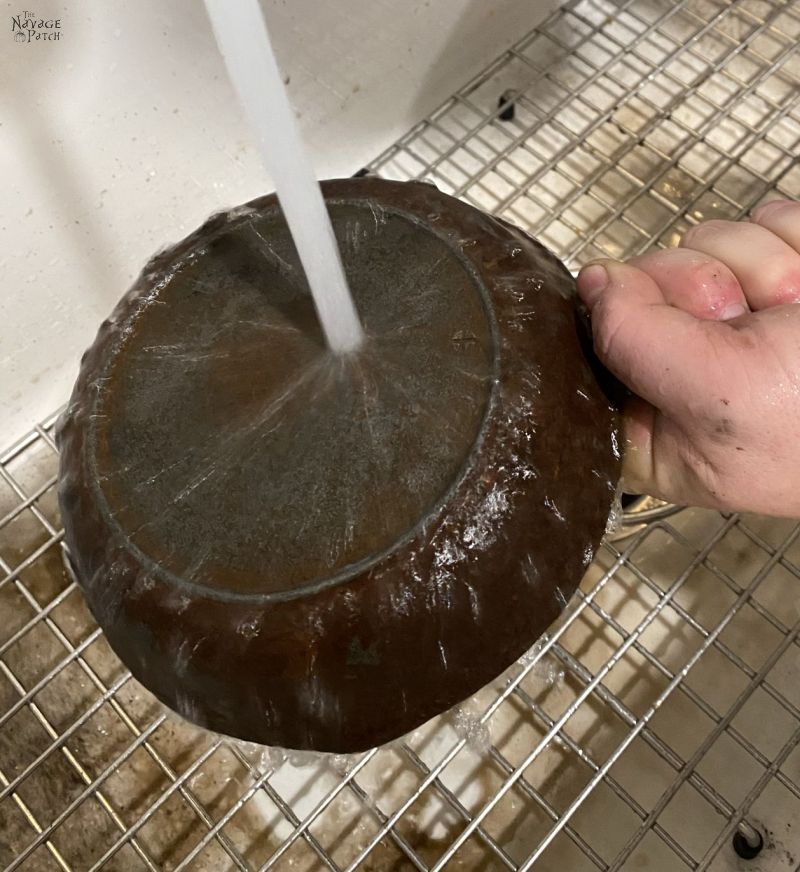
Soon, I had the pan looking almost as good as new. The decades of corrosion had left the cooking surface pitted and pockmarked – those imperfections can’t be fixed, but the rust was gone. Just to make sure I got all the pits cleaned out, I gave it another 2-hour bath and then a final scrubbing.
In the future, I would skip the initial scrubbing and go directly to the vinegar bath. If after 24 hours and scrub, it still needed more, I’d give it another bath. I’d prefer to give time rather than energy to my next cast iron pan restoration!
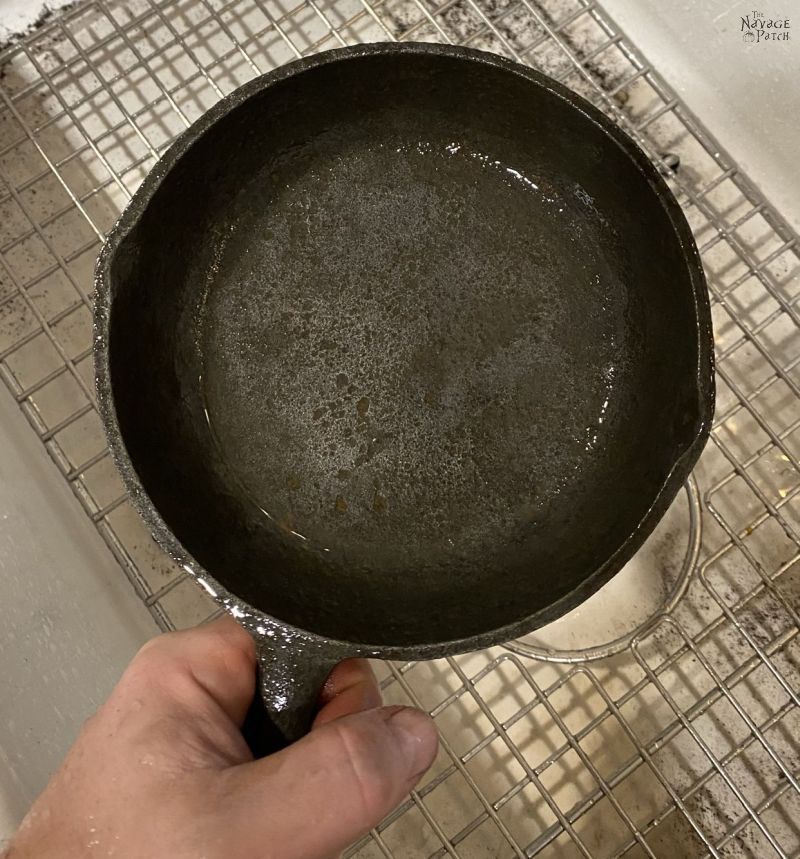
You can see all the iron dust in the sink.
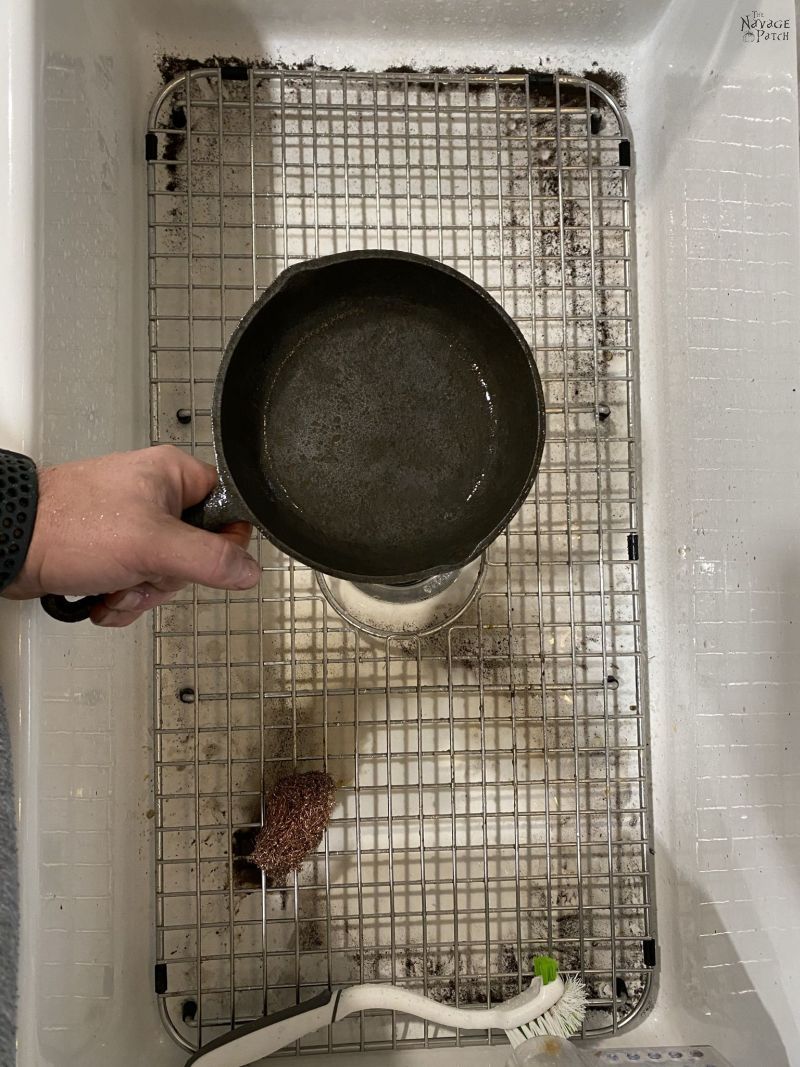
This pan is as restored as it’s going to get without bringing in power tools.
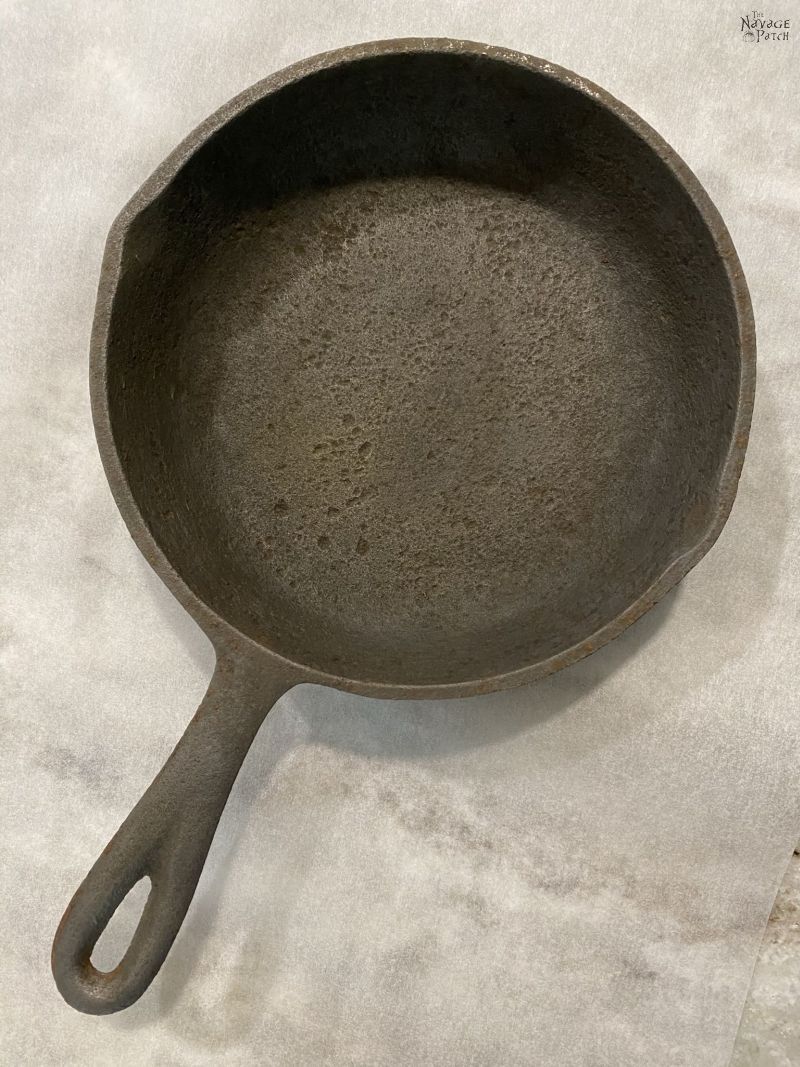
But it’s not ready for cooking. First this cast iron pan needs to be seasoned.
Seasoning Cast Iron Pans
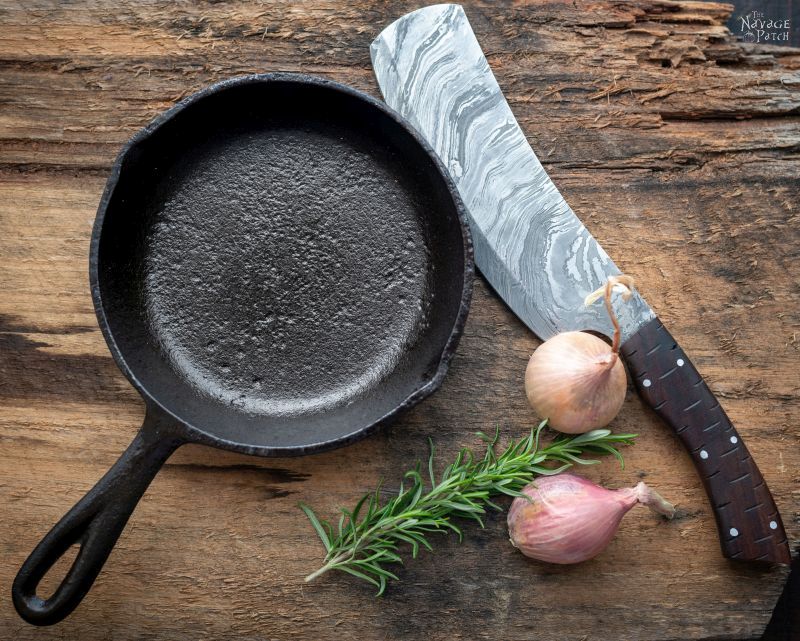
Why Season Cast Iron Pans?
Seasoning cast iron accomplishes two things:
- It prevents rust. Cast iron is not stainless steel – it rusts when exposed to water or humidity.
- Over time, regular seasoning will produce a nearly-non-stick cooking surface.
Now, this particular pan will probably never be non-stick again due to the corrosive pitting, but that’s okay. It’s main job from here on out is as a photo prop.
How Does Seasoning Work?
Seasoning simply means wiping a very thin coat of oil all over the pan and then baking it. The heat polymerizes the oil – that is, it hardens it into a protective shell. Certain oils like walnut oil and linseed oil polymerize without baking – that’s why they are used as finishes in woodworking. But for cooking, vegetable oils are best, and they are easily polymerized with heat.
The Enemies of Seasoned Cast Iron
Acid is the number one enemy of seasoned cast iron pans, and if you’re not inclined to be seasoning on a regular basis, it’s best to avoid cooking acidic foods for prolonged periods. This means tomato sauces, anything with lime or lemon juice or vinegar. But even simmering or braising non-acidic foods will eventually take its toll on a seasoned pan. Also, the protective polymer shell will break down after prolonged exposure to ultra-high temperatures, like those achieved when searing meat.
How Often Should You Season Your Cast Iron Pans?
As often as needed, and that is going to differ from cook to cook. I need to season often, because I don’t follow the rules, and I’m always cooking tomato-based sauces and other acidic foods in my cast iron pans. But that’s okay, I don’t mind the process! A well-seasoned pan will have a glossy black finish, with no dull or flat areas. You’ll often find the flat area in the middle of the pan, and over time, it will spread outward. Best to season before that happens.
How to Season a Cast Iron Pan
Step 1 – Preheat oven
Preheat oven to 375 f (190 c), and cover the bottom of the over with aluminum foil.
Step 2 – Oil the pan
To season a cast iron pan, add a spoonful of vegetable/canola/sunflower oil to the pan (don’t use olive oil, as it has a smoke point of about 350 degrees – below the temp you’ll be seasoning at) and wipe it around with a paper towel. Be sure to oil every bit of the pan, including the handle. Wipe off any excess oil – you don’t want to see it running or pooling anywhere. Too much oil will leave your pan tacky.
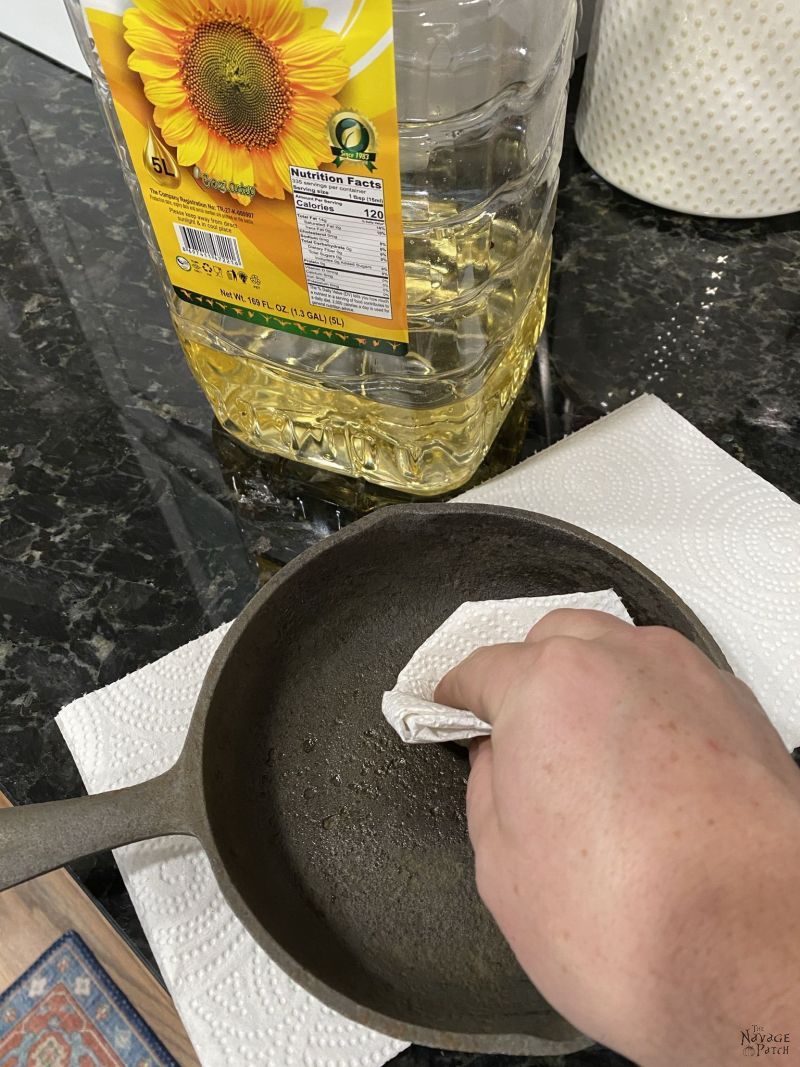
This is the amount of oil you want.
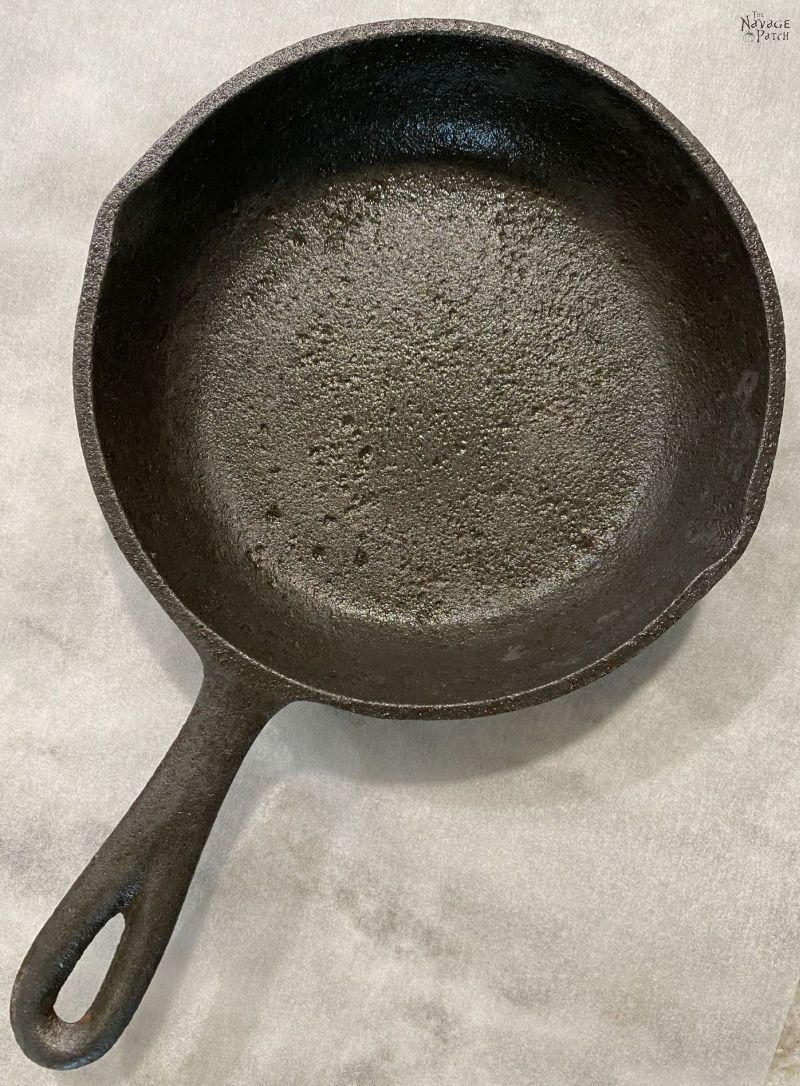
Place the pan upside down in the oven and bake for 1 hour. After an hour, turn off the heat, and let the pan cool in the oven.
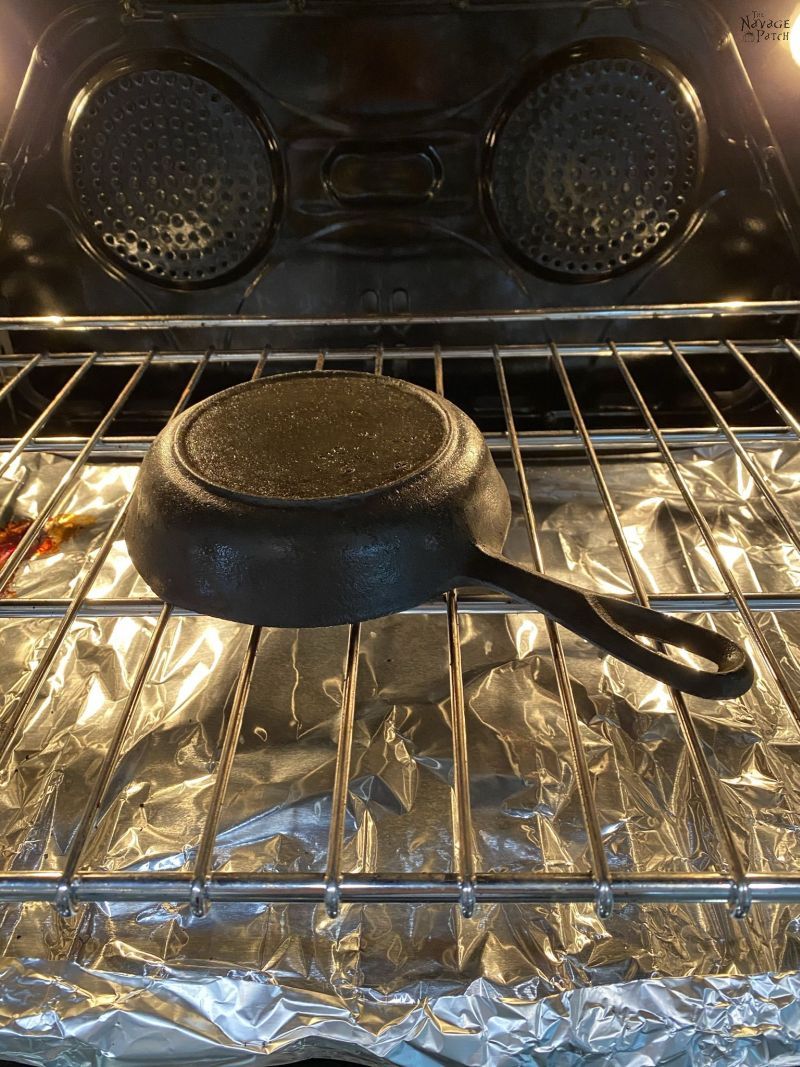
Step 3 – Repeat, if necessary
Most places will tell you that your pan is ready after one seasoning – and if you’re just doing a maintenance seasoning on your pan, that may be the case. But I’ve found for pans that have needed to be restored first – that is, they needed rust removal and deep scrubbing – 3 and sometimes 4 seasoning are necessary to bring the pan back to where it needs to be.
For this little disaster, I seasoned it 5 times. I probably could have stopped after 3 or 4, but I had the time, so I kept going. The picture below is how it looked after the first seasoning. You can see the sidewalls of the pan are blotchy with dull areas – indicative of a need for further seasoning.
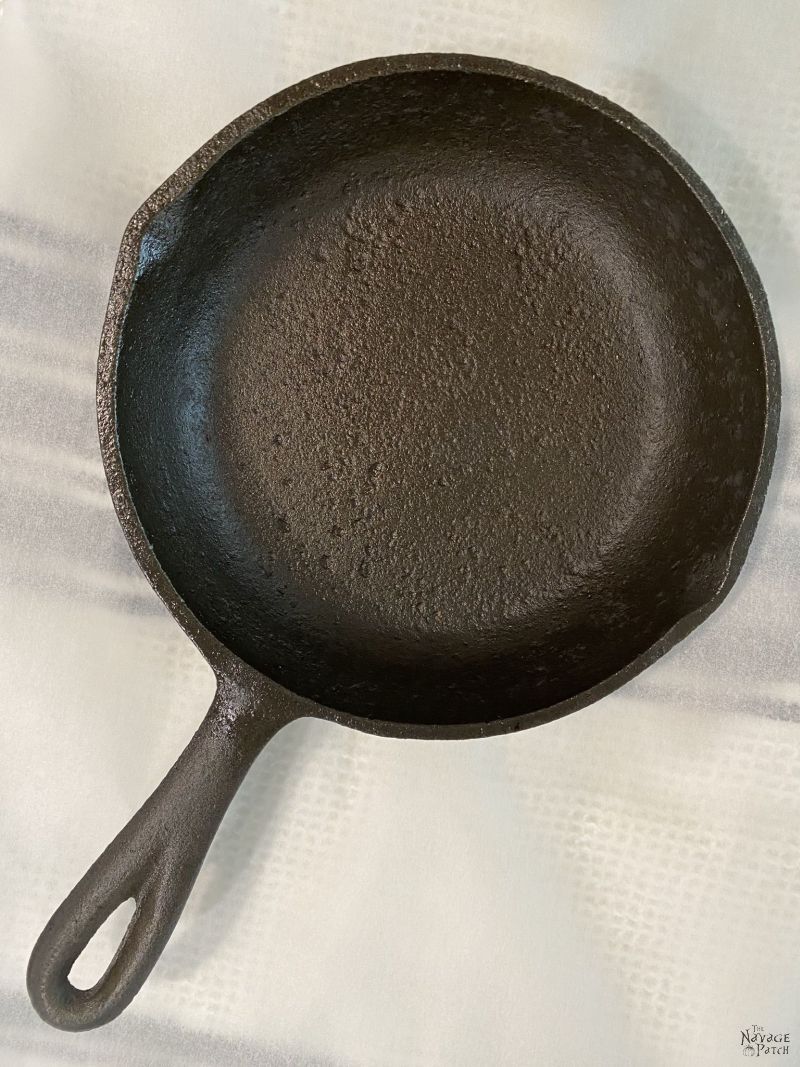
What a difference!
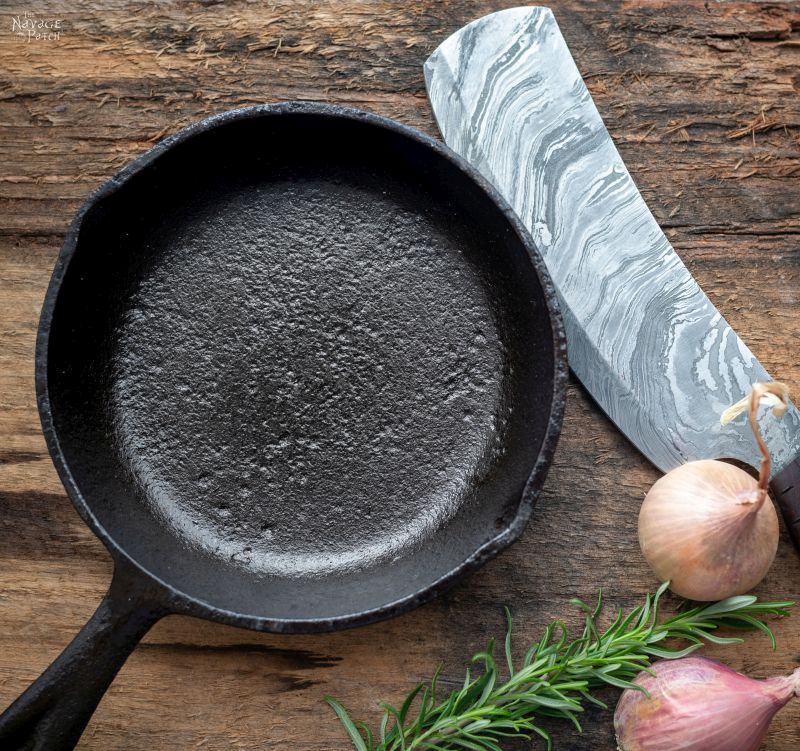
We love it when you share our posts on Facebook and Pinterest!
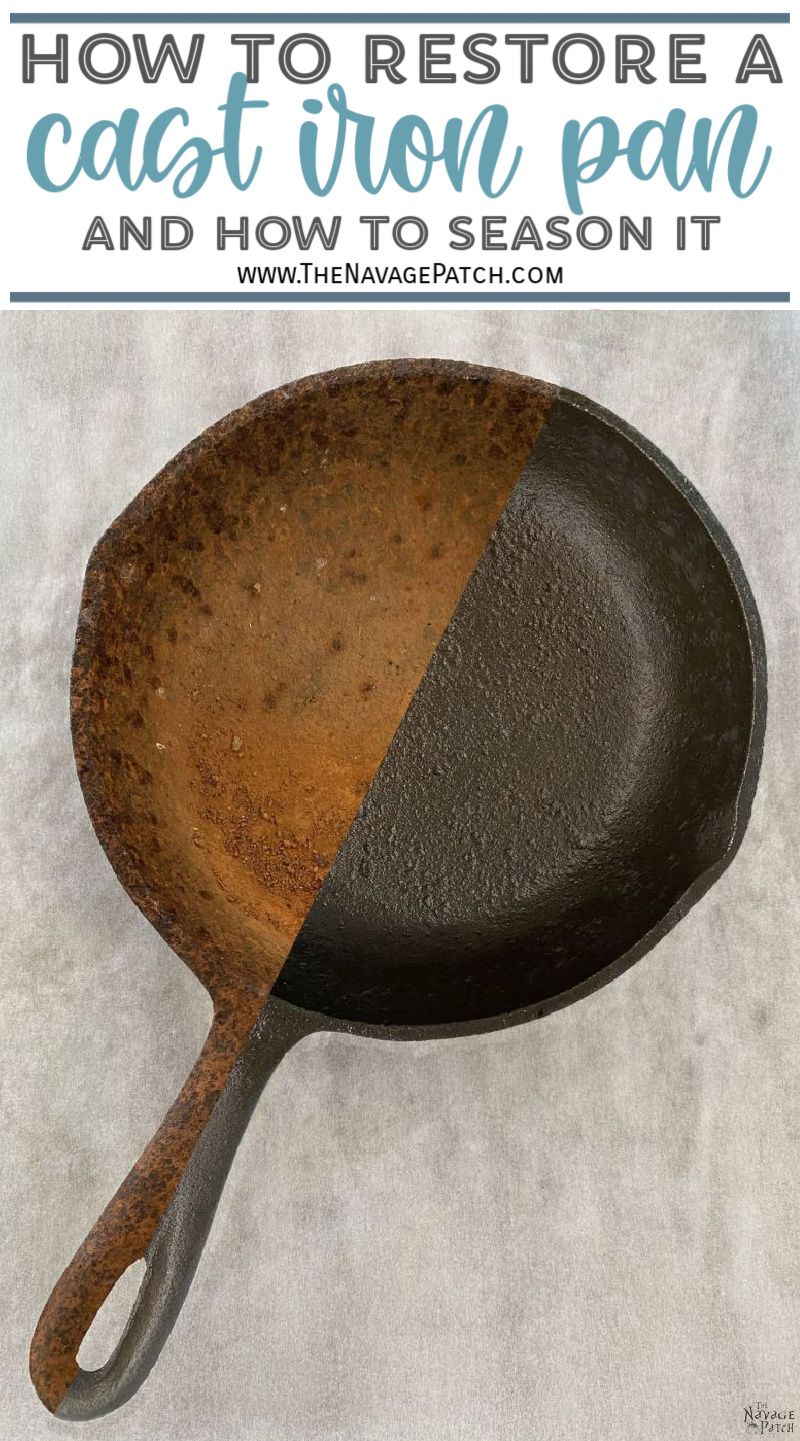
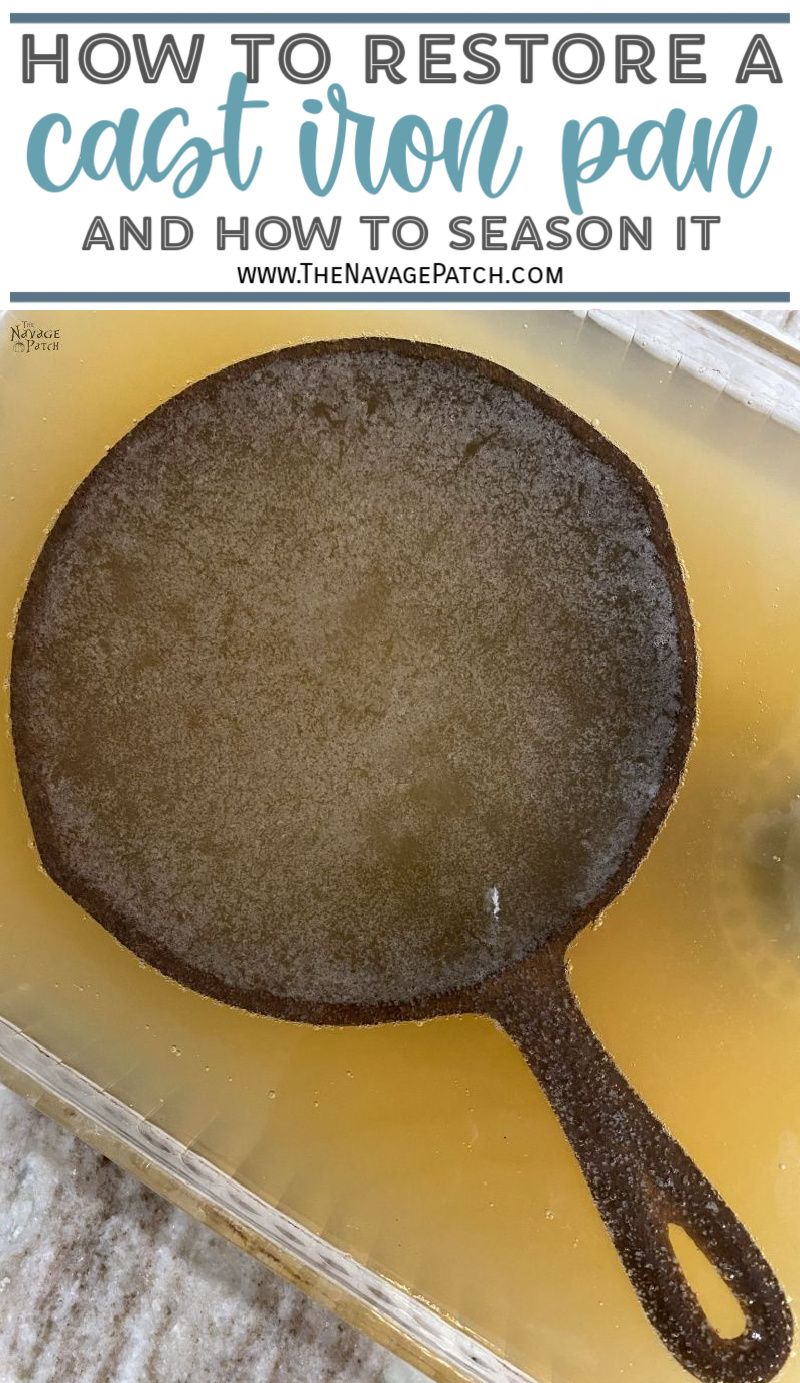


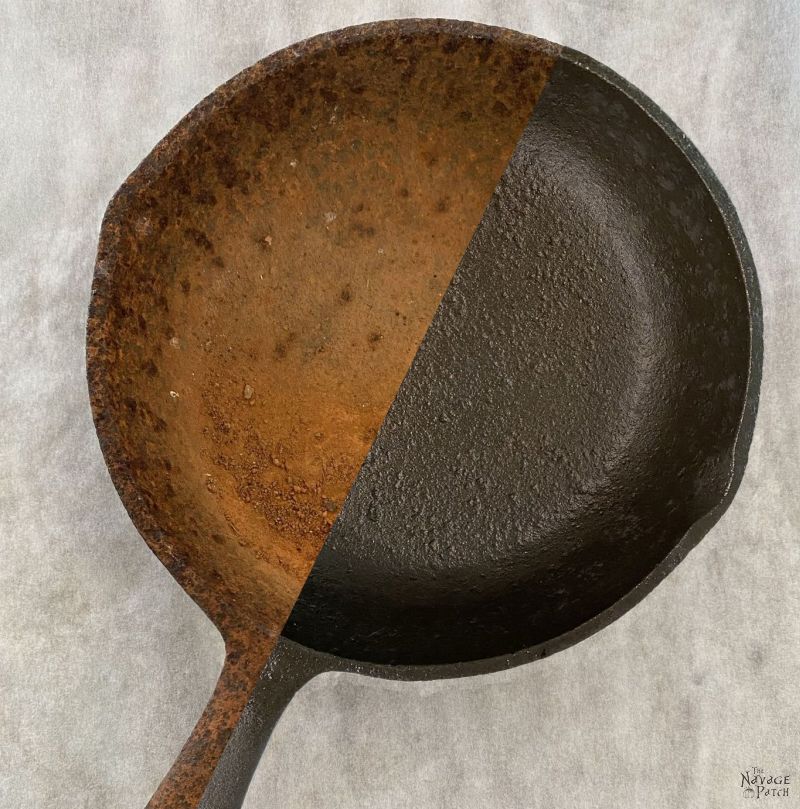
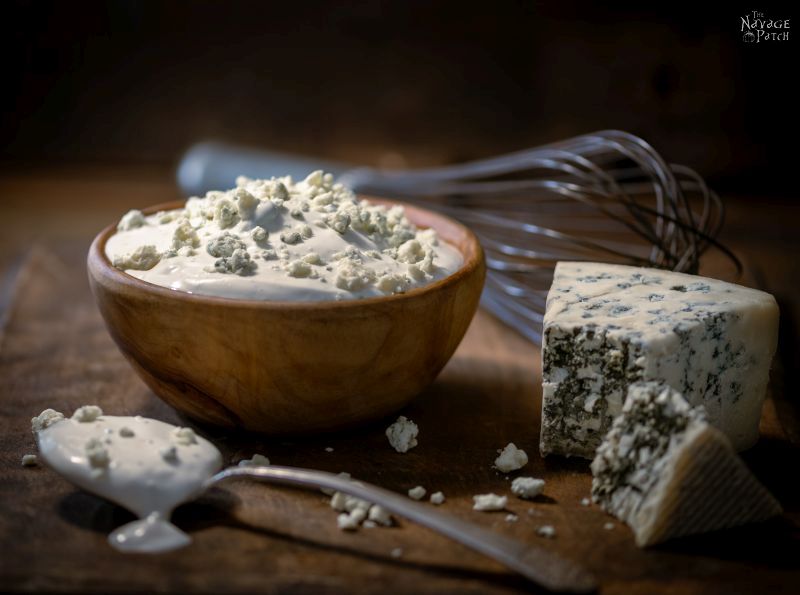




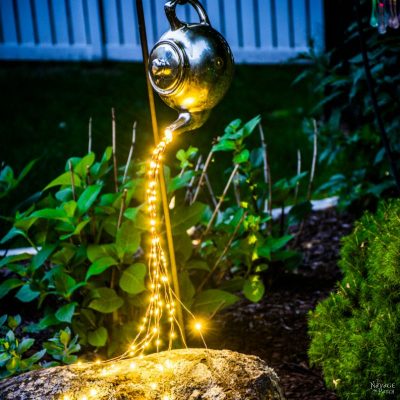
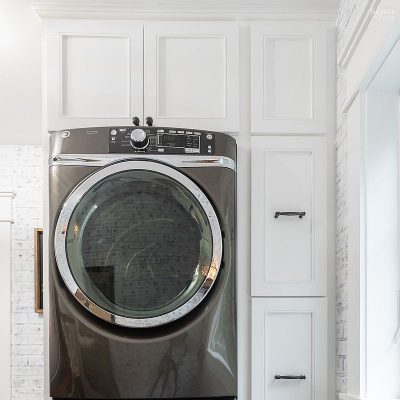


I have had great success by putting the pan in the oven on the self-clean option. When I took it off most everything brushed right off. I did it with a 100 year old cast iron waffle iron that looked like your pan. It was a good send for getting in all the nooks and crannies.
Oh wow, I wouldn’t have thought of that! Unfortunately, my oven doesn’t have a self-clean option, so it’s vinegar and steel wool for me! 🙂
That usually works for me, too, but I did have one pan crack the first time. It was an older pan, and likely already had a fracture. The shame of it was that it was my favorite one!
Easy Off oven cleaner with the yellow cap works great for restoring cast iron too. Just spray the pan, stick it in a black garbage bag and let it sit for about a week. Then check it and, if needed, let it sit a bit longer. If the pan is really bad it may have to be done a few times. Then clean the oven cleaner off and season as usual.
Another good tip! Thanks, Pam! 🙂
Wow, this sounds scary to me, how many times does it take that to remove those chemicals from the pan?
I found if you spray the cast iron with oven cleaner on newspapers outside, then rinse with a hose and scrub any spot with sos. Then season them as you described. I also use the oven cleaner on all my cookie sheets and Pyrex glass. I don’t just do one pan, I wait until I have a few pans or dishes.
That’s a good tip, Jeanne – I will get some oven cleaner!
I found a bigger worse looking pan under the front porch of my husbands house after we married. I’m sure it was put there by one of his sons or maybe even his ex-wife. It had a half of an inch of crud in the bottom. I finally got it cleaned. Wish I’d known about the vinegar. Reseasoned it and used it for a good while. After all the kids left and it was just husband and me, I gave it to my daughter. She had two growing boys and needed it. It’s really good to know about the vinegar. Thank you!
It’s really satisfying to restore cast iron, isn’t it! A good pan or pot is a great gift to hand down through the generations. My mom gave me a beautiful medium-sized cast iron pan a few years ago. She’d had it forever. The cooking surface was like black glass. I couldn’t wait to put it o use, so I put it on a burner, cranked the heat to high and prepared to sear a steak. Before I got the meat anywhere near the pan, I hear a loud CRACK. Ran to the stove to see that beautiful pan split right down the middle. It didn’t fall into two pieces, but it cracked all the way through the pan. I was so bummed!
I spray my cast iron skillet with seasoning spray after I clean it and reheat it on a burner to keep it nice and seasoned. It cleans up after use easily too. I always cook my steaks in it (unless we cook them outside on the grill).
Yep, that’s the best way, Laurie. All it takes is a little bit of maintenance each time! Still, I’m always breaking the rules with mine, so I’m doing a full seasoning roughly every season! 🙂
Why not use olive oil for seasoning? Thank you!
Hi Linda, olive oil has a very low smoke point compared to other oils – about 350 compared to 400+ for veggie and nut oils. Because of this, the oil will burn instead of polymerize, and you won’t get the protection you’re looking for.
Olive oil burns too easily. You need to use a “tougher oil” such as canola or coconut. I always season my cast iron with coconut oil – after every use, I rub the clean pan with coconut oil and warm the skillet for a few minutes.
Greg,
An easier way to clean your old, rusty, pitted cast iron finds is to put it in a plastic tote and pour enough ammonia over it so that it is submerged. Cover the pan and let the skillet/pan soak for 2 or more days. Take it out of the ammonia and clean well with soap and hot water, then season as you recommended. I’ve cleaned really bad cast iron like this. Ammonia is cheap and plentiful. Wear a mask if you’re going to be exposed to the smell very long. All the oven cleaners have ammonia in them. It cuts the grease and burned on crud and it just slides off in the water.
That’s a good tip, Barbara. I’m going to get some ammonia. Do you know, I’ve never in my adult life bought or owned straight ammonia? LOL, I think it’s time I get on the bandwagon! 🙂
This is a new method I had not heard of before. I will have to try it next time. Thanks.
I just have to say, I really enjoy the Navage Patch. Been following your home DIY adventures for about 2 years. Oh, welcome to Georgia, I am about 30 minutes north of you.
Thank you so much, neighbor Dee!
Thank you for sharing useful tips on cast iron
You’re very welcome! 🙂
If you can find someone with a sand blaster, they could smooth out the pits in the bottom. My Grandpa taught me to season cast iron with lard and salt. Heat the skillet up really hot, open fire is the best to open the ‘pores’, add a scoop of lard, pour in course salt and with a rag rub the lard into the pores and polish with the salt. Repeat til the lard doesn’t soak in. Use the soaked rag to wipe off the black on the bottom of the pan if done over an open fire. Every year at hunting camp we seasoned our cast iron. But this method works on the stove top, as well.
Ohhh, the fun I could have with a sand blaster! I love the lard idea – everything is better with lard! Next time I get lard for biscuits, i’ll use some on my cast iron! 🙂
Thanks so much for this tutorial! This is the first article I’ve read on restoration and maintenance that I’ve actually understood. Now to stop using olive oil when I’m curing the iron 🙂
Thank you so much, Lacey – I’m glad you found it useful! Yes, definitely switch to a vegetable or seed oil. 🙂
Wow. This really did deserve a “Holy Cow!” when the rust came right off. I’ve been reading your blog since last summer and have really enjoyed it–thanks for sharing all your projects with us. I’m with you on the term “antiquing”–it’s an odd word. I always go “junking”. It sounds more fun and adventurous, and someone else’s junk could be the treasure I never knew I needed until I found it.
I know, right? I couldn’t believe I got it fully restored! I wish they’d call it junking everywhere – it might help with some of the ridiculous prices at some of these “antique” shops, lol!
Great tips, will definitely give mine a little TLC after reading this. Thank you!
Thank you, Erin! 🙂
Great timing on this post. I have an old 8-section cornbread pan sitting on my island now that we found on a late night walk with our dogs. A neighbor had thrown it out (shocked face). I’ve been too busy (lazy) to look up the process for derusting and reseasoning, but I read every Navage Patch post, so now I know what I will be doing on Sunday. Thanks, Greg!
Oh, great find, Kat! Those cornbread pans are awesome! Read through the other comments here – there are some great tips in case you’re not able to scrub those wedge-shaped sections. Good luck with it!
Hi Greg. I have a whole set of cast iron pans in my cupboard that I MUST get out and re-season. Thanks for the ‘kick up the bum’ LOL.
BTW did you realise that Google Chrome is putting HUGE ads over the left side of your blog which it making it almost impossible to read (with the ad at the bottom and the one at the left there is about 4 inches left to read in!!) 🙂
Hi Jayne, Handan and I tried to recreate what you were seeing, but we weren’t able to. Are you viewing our page with text magnification? Would it be possible for you to take a screenshot next time you see it? Thanks!
Fabulous post! Always amazes me that so many do not know about vinegar. I use it for so many things other than making salad dressing or to pickle something. Cast iron is the number one workhorse in my kitchen and since I cook everyday for my 9 bubble buddies, they see a lot of action. Can’t wait for your food blog and all the props you must have collected!
Thank you, Naomie! I totally agree – I always have an enormous jug of white vinegar on hand – it’s almost as essential as onions in my kitchen! We’re gearing up for the food blog launch – probably later this year! 🙂
All I have is apple cider vinegar. Will that be ok to use? I have a pan similar in condition as this one was.
Hi Angela, apple cider vinegar should be fine. White vinegar is cheaper, so that’s why I used it for this cleaning hack.
For a pan like this I would used electrolysis. But thank you for the vinegar bath information. I have a slightly rusted pan that I will use vinegar on. Thank you.
Electrolysis? Wow, I haven’t heard of that technique – I’m off to Google! 🙂
I’ve used cast iron skillets since I was a little girl standing on a stool to reach the top of the stove. This was the drill at our house to maintain the pans. Wash the dishes (by hand — no dishwasher), clean the stovetop, wash the cast iron pan, put it on the stovetop on high heat. When all the water has evaporated, put in a glug of oil (corn, canola, soy — any ordinary oil on hand), allow it to “shimmer,” then spread it around with a pad of paper toweling, up the sides and all over the bottom. Turn off the heat and leave the pan on the burner to cool. Finish cleaning the rest of the kitchen (you already did the stove before you reheated it). When the pan is completely cold, wipe out any remaining oil and stow it away. Do this every time you use your cast iron. Sounds a lot more complicated than it is. I do it like clockwork.
That’s the way I learned too! If you follow that procedure, your cast iron will always be perfect!